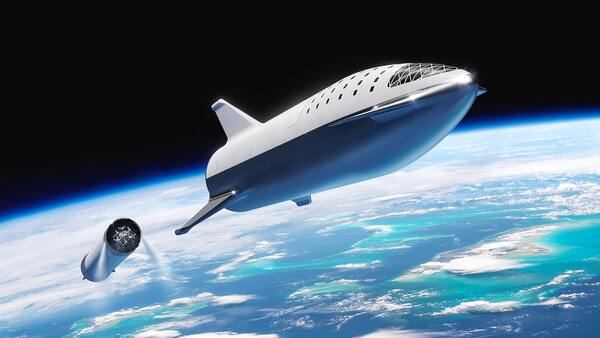This article explores The ethical implications of creating self-replicating spacecraft: Examining the risks and benefits. Find out more about The ethical implications of creating self-replicating spacecraft.

In the vast expanse of the cosmos, humanity has long harbored dreams of exploring and colonizing distant worlds.
To turn these visions into reality, scientists and engineers have constantly pushed the boundaries of technological innovation.
One such concept that has captivated the imagination of both experts and enthusiasts alike is the idea of self-replicating spacecraft. These hypothetical machines possess the ability to reproduce themselves, potentially leading to an exponential growth in space exploration capabilities.
Self-replicating Spacecraft And The Consequences For Humanity
With the revolutionary potential of self-replicating spacecraft comes a host of ethical implications that demand careful consideration.
As humans inch closer to the realization of self-replicating spacecraft, it becomes imperative to critically examine the risks and benefits associated with this technology.
Such an exploration invites a thoughtful evaluation of the consequences for humanity, the environment, and the very fabric of our understanding of space exploration.
This essay aims to delve into the ethical dimensions surrounding the creation of self-replicating spacecraft, shedding light on the multifaceted issues at hand.
By analyzing both the potential benefits and the inherent risks, we can strive for a comprehensive understanding of the ethical quandaries arising from this technological advancement.
It is only through such examination that we can navigate the path toward responsible and morally sound decision-making in the pursuit of space exploration.
In the following sections, we will explore the advantages that self-replicating spacecraft offer, including their potential to expand human presence in space, increase scientific knowledge, and enable resource utilization in extraterrestrial environments.
However, we must also confront the concerns that arise, such as the uncontrolled proliferation of technology, the impact on celestial bodies and ecosystems, and the potential for unintended consequences that may disrupt delicate cosmic balances.
By taking a balanced approach, this examination aims to foster a meaningful dialogue and encourage thoughtful discourse among scientists, policymakers, ethicists, and the public.
The future of space exploration hangs in the balance, and it is our collective responsibility to ensure that progress is made in an ethically sound manner.
Only through careful consideration of the potential risks and benefits can we forge a path toward a future where humanity’s extraterrestrial endeavors align with our moral compass.
As we embark on this exploration of the ethical implications surrounding self-replicating spacecraft, it is vital to remember that the decisions we make today will shape the trajectory of human presence in space for generations to come.
The Ethical Implications Of Creating Self-replicating Spacecraft
The creation of self-replicating spacecraft presents a range of ethical implications that necessitate thorough examination and consideration.
Addressing these ethical implications requires a comprehensive approach involving scientific research, policy development, international cooperation, and public engagement.
By actively considering and integrating ethical considerations into the design, deployment, and regulation of self-replicating spacecraft, we can strive for responsible and sustainable space exploration that aligns with our moral principles and respects the integrity of the cosmos.
Here are some key ethical concerns associated with this technology:
Environmental Impact:
Self-replicating spacecraft could potentially disrupt celestial bodies and ecosystems within the solar system and beyond. Uncontrolled replication and resource utilization on planets or moons may lead to irreparable damage to fragile extraterrestrial environments. Ethical questions arise regarding our responsibility to preserve and respect these celestial bodies as we explore and exploit their resources.
Unintended Consequences:
The complexity of self-replicating systems introduces the risk of unintended consequences. If not designed with extreme care and fail-safe mechanisms, these spacecraft could inadvertently cause harm or disruption. Malfunctioning or unchecked replication could lead to resource depletion, interference with existing space infrastructure, or even the propagation of harmful materials or technology.
Uncontrolled Proliferation:
The ability of self-replicating spacecraft to reproduce autonomously raises concerns about uncontrolled proliferation. If replication is left unchecked, it may lead to an overwhelming number of spacecraft operating independently in space. This unregulated growth could result in overcrowding, conflicts over resources, and potential hazards to existing satellites, space debris, and future missions.
Ethical Boundaries of Exploration:
The creation of self-replicating spacecraft forces us to consider the ethical boundaries of space exploration. What are the limits to human presence and intervention in extraterrestrial environments? How do we balance the pursuit of knowledge and progress with the need to respect and preserve the natural order of the cosmos? These questions call for a careful examination of our responsibilities as explorers and custodians of space.
Socioeconomic Implications:
The development and deployment of self-replicating spacecraft may have socioeconomic consequences. The potential for automation and the self-sufficiency of these machines could lead to job displacement and economic inequality, particularly if the benefits of space exploration and resource utilization are not equitably distributed among nations and communities.
Dual-Use Technology:
Self-replicating spacecraft, if developed with advanced capabilities, may have dual-use potential. While they can serve peaceful purposes like space exploration and scientific research, the same technology could be repurposed for military applications. The ethical dilemma lies in managing the potential for misuse and ensuring that safeguards are in place to prevent the weaponization of self-replicating technology.
Advantages That Self-replicating Spacecraft Offer
Self-replicating spacecraft offer several potential advantages that can significantly impact space exploration and our understanding of the cosmos.
It is important to note that while these advantages hold great potential, they must be weighed against the ethical implications and risks associated with self-replicating spacecraft.
Responsible development, careful regulation, and thorough consideration of the broader societal, environmental, and ethical implications are essential to harness the potential benefits while mitigating potential drawbacks.
Here are some key advantages:
Expansion of Human Presence:
Self-replicating spacecraft have the potential to expand human presence in space on an unprecedented scale. By autonomously replicating and building new spacecraft, they can facilitate the establishment of colonies or outposts on distant celestial bodies. This advancement could enable sustained human exploration and habitation beyond Earth, opening up new frontiers for scientific research, resource utilization, and potential long-term survival.
Increased Scientific Knowledge:
Self-replicating spacecraft could accelerate scientific exploration and discovery. With the ability to self-reproduce, these spacecraft can multiply their numbers, enabling simultaneous exploration of multiple regions or celestial bodies. This proliferation would expand the scope of scientific observations, sample collection, and experiments, leading to a deeper understanding of planetary processes, celestial phenomena, and the origins of our universe.
Resource Utilization:
Self-replicating spacecraft hold the potential to harness and exploit extraterrestrial resources. By reproducing and constructing new spacecraft, they can establish mining and extraction operations on other celestial bodies, such as the Moon, asteroids, or Mars. This capability could unlock access to valuable resources like minerals, water, and rare elements, reducing the dependence on Earth’s resources and potentially enabling sustainable off-world infrastructure.
Resilience and Redundancy:
Self-replicating spacecraft offer resilience and redundancy in space missions. In case of failures or accidents, the ability to autonomously repair or replicate new spacecraft ensures the continuity of exploration and mission objectives. This redundancy can minimize the impact of unexpected events and enhance the overall reliability of space exploration endeavors.
Efficiency and Cost Reduction:
Self-replicating spacecraft have the potential to increase efficiency and reduce costs associated with space missions. By replicating themselves, they can avoid the need for repeated launches from Earth, where launching payloads into space is resource-intensive and expensive. This capability may lead to a more sustainable and cost-effective approach to space exploration, enabling more ambitious and frequent missions.
Rapid Infrastructure Development:
Self-replicating spacecraft can accelerate the development of space infrastructure. By replicating and constructing new spacecraft, they can assist in the assembly of large structures, such as space habitats, solar power stations, or communication networks. This capability could facilitate the creation of a robust infrastructure framework that supports long-term space exploration and potentially paves the way for future human settlements in space.
Is The Use Of Self-replicating Spacecraft Worth The Risk
Determining whether the use of self-replicating spacecraft is worth the associated risks is a complex question that requires careful consideration of various factors.
The answer ultimately depends on the specific context, the level of technological development, and the effectiveness of risk mitigation strategies. Here are some points to consider when evaluating the worthiness of the risks:
Potential Benefits:
Assess the potential benefits that self-replicating spacecraft offer. Consider the advantages mentioned earlier, such as the expansion of human presence in space, increased scientific knowledge, resource utilization, efficiency, and cost reduction.
Evaluate the potential impact these benefits could have on space exploration, scientific advancements, and the long-term sustainability of human presence beyond Earth.
Risk Assessment and Mitigation:
Evaluate the identified risks associated with self-replicating spacecraft and assess the effectiveness of risk mitigation strategies.
Consider the feasibility and reliability of fail-safe mechanisms, environmental protection measures, controlled replication protocols, and oversight mechanisms to minimize the identified risks.
Determine if the level of risk can be reduced to an acceptable and manageable level through proper planning, regulations, and safeguards.
Ethical Considerations:
Examine the ethical implications and ensure that the use of self-replicating spacecraft aligns with ethical principles.
Consider the impact on the environment, the potential for unintended consequences, and the adherence to ethical boundaries in space exploration.
Assess whether the potential benefits outweigh any ethical concerns or if there are alternative approaches that could achieve similar objectives with lower risks.
International Collaboration and Governance:
Consider the importance of international collaboration and governance frameworks. The development and use of self-replicating spacecraft require global cooperation to ensure responsible and safe practices.
Evaluate the existing or potential mechanisms for international cooperation, regulations, and agreements to manage the risks and benefits associated with self-replicating spacecraft.
Long-Term Vision and Planning:
Consider the long-term vision and planning for space exploration. Assess how self-replicating spacecraft fit into broader exploration strategies and whether they align with long-term goals and sustainability principles.
Evaluate if self-replicating spacecraft are a necessary and viable means to achieve these goals or if alternative approaches can achieve similar outcomes with lower risks.
Ultimately, the worthiness of the risks associated with self-replicating spacecraft depends on a careful and balanced evaluation of the potential benefits, risk mitigation strategies, ethical considerations, international collaboration, and long-term vision for space exploration.
It is important to approach the development and use of this technology with a responsible and comprehensive mindset, ensuring that the benefits outweigh the risks and that safeguards are in place to minimize potential negative impacts.
‘The ethical implications of creating self-replicating spacecraft: Examining the risks and benefits’ is one important topic in our series exploring the role of Von Neumann machines in space colonization.
Read more about these topics by following the links below:
Republished by Blog Post Promoter
